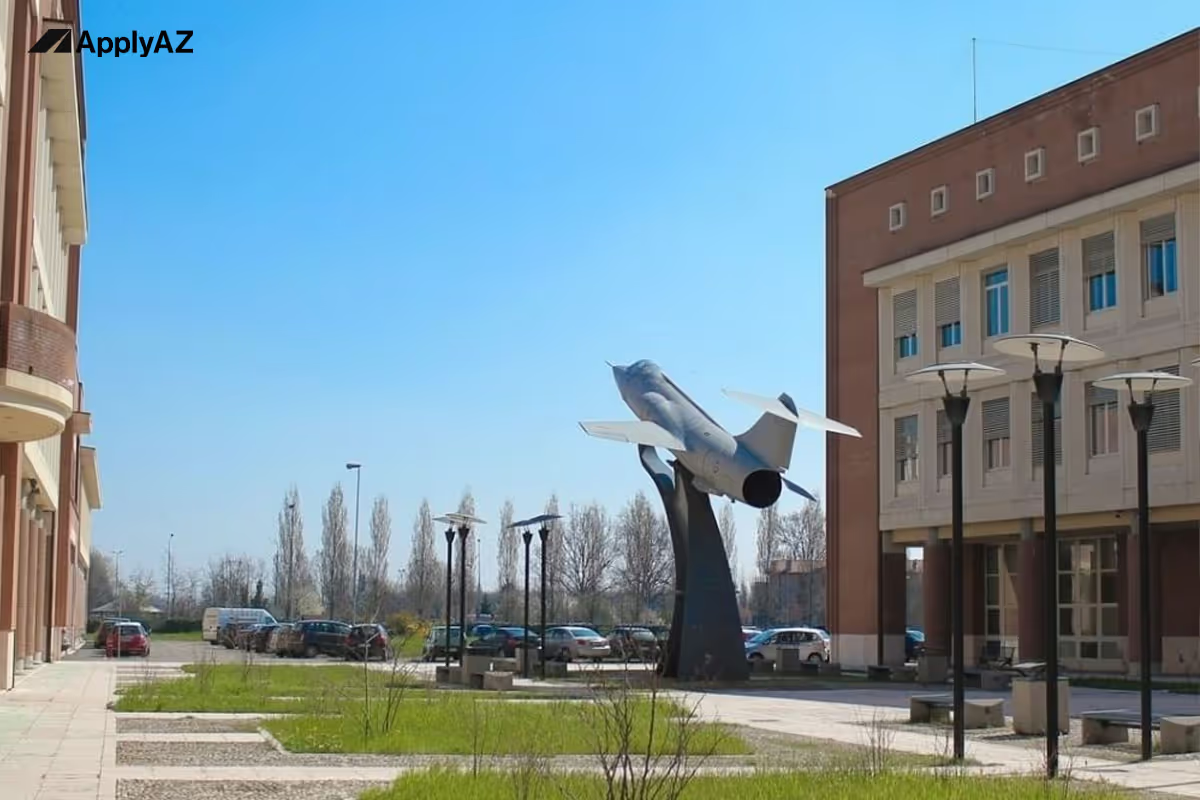Heading
Heading








University of Modena and Reggio Emilia
A historic university with a modern global vision
The University of Modena and Reggio Emilia (Università degli Studi di Modena e Reggio Emilia), often called UNIMORE, is one of the oldest yet most forward‑looking public Italian universities. Founded in 1175 and re‑established in the seventeenth century, it has grown into a research‑driven institution with strong international links. Each year, thousands of students choose UNIMORE’s English‑taught programs in Italy to study in Italy in English and join a community focused on innovation, inclusion, and real‑world impact.
Academic excellence across centuries
UNIMORE consistently earns places in major global rankings for research output and teaching quality. It is particularly strong in engineering, life sciences, economics, and humanities. The university maintains partnerships with over 300 institutions worldwide, encouraging exchange programmes and joint research. Its modern laboratories, digital libraries, and interdisciplinary centres help scholars tackle complex problems in health care, mobility, sustainability, and artificial intelligence.
A dual‑campus advantage
The university operates two main campuses—Modena and Reggio Emilia—located just 30 minutes apart by train. Students benefit from double resources: specialist faculties in each city, joint events, and shared career services. Key departments include:
- Department of Engineering “Enzo Ferrari” (automotive, mechanical, and materials)
- Department of Chemical and Geological Sciences (environmental technology)
- Department of Life Sciences (biomedical research and biotechnology)
- Department of Economics “Marco Biagi” (business analytics and finance)
- Department of Education and Humanities (languages, social policy, arts)
English‑taught programmes in Italy: What UNIMORE offers
UNIMORE currently delivers more than a dozen full master’s courses and several bachelor’s tracks entirely in English. Popular options range from Automotive Engineering and Advanced Automotive Electronic Engineering to International Management, Artificial Intelligence, and Data Analysis for Economics. Course directors design syllabi with an eye on industry needs, ensuring students develop technical depth and soft skills useful worldwide.
Small class sizes foster direct interaction with professors who often carry out cutting‑edge research funded by the European Union and private companies. Many modules blend lectures with project work, allowing students to apply knowledge to real data, prototypes, or policy cases.
Living and learning in Modena and Reggio Emilia
Compact, student‑friendly cities
Modena and Reggio Emilia share Emilia‑Romagna’s warm hospitality, rich cuisine, and human‑scale urban planning. Both centres are walkable and cycle‑friendly, with dedicated lanes and rental schemes. Students enjoy a lower cost of living than in Milan or Rome: shared flats near campus, discounted canteen meals, and affordable cultural passes keep budgets under control.
Climate and transport
The climate is temperate continental, bringing hot summers perfect for outdoor festivals and mild, misty winters ideal for museum visits. High‑speed trains connect the campuses to Bologna in 20 minutes, Florence in an hour, and Milan in under two hours. Local buses and regional trains run late, helping students balance study, social life, and travel.
Culture and leisure
UNIMORE students quickly discover treasures such as Modena’s UNESCO‑listed cathedral, Reggio’s modern art galleries, and dozens of theatres, jazz clubs, and literary cafés. Food culture is legendary—think balsamic vinegar, Parmigiano Reggiano cheese, and fresh pasta. Weekly language tandems, Erasmus socials, and volunteering projects make integration smooth for newcomers.
Student experience and support
International students receive guidance from dedicated offices on visas, residence permits, and accommodation. Welcome Weeks, buddy schemes, and Italian language courses aid cultural adjustment. Libraries stay open late, group‑study rooms can be booked online, and digital platforms provide lecture recordings and career advice.
Sport is another pillar of campus life: fitness centres, football leagues, volleyball teams, and even rowing on the Secchia River encourage a balanced lifestyle.
Job and internship landscape
Industries that power the region
Emilia‑Romagna is a powerhouse of advanced manufacturing and services. Key sectors include:
- Automotive and motorsport: Ferrari, Maserati, Ducati, and dozens of specialist suppliers are headquartered nearby.
- Food technology: Barilla, Mutti, and local artisan producers recruit graduates skilled in quality control and supply‑chain analytics.
- Ceramics and materials: The “Tile Valley” between Modena and Sassuolo is Europe’s largest ceramic district, demanding engineers and sustainability experts.
- Healthcare and biomedical: Public hospitals and private R&D labs collaborate with UNIMORE’s medical faculty on robotics, regenerative medicine, and public‑health data.
- Digital and AI: Start‑ups at Modena’s Technopole and Reggio’s Innovation Hub focus on smart manufacturing, fintech, and green mobility.
How students benefit
UNIMORE’s Career Service arranges over 3,000 internships annually. Many begin in the second semester, combining academic credit with paid experience. Career fairs, hackathons, and project challenges let students pitch directly to HR teams. Graduates often find full‑time roles in the same firms, supported by Italy’s “Blue Card” pathway for non‑EU talent seeking long‑term residency.
Scholarships, DSU grant, and financial support
While tuition fees at UNIMORE are already moderate compared with many Western institutions, further help is available. The Emilia‑Romagna regional authority offers the DSU grant, which can waive fees and provide monthly allowances for rent and meals. The university also awards merit scholarships for high‑performing international students and research bursaries tied to departmental projects. Application procedures are clear, with online portals and English‑speaking staff ready to assist.
Why choose UNIMORE and Emilia‑Romagna?
- Balance of heritage and innovation: Study in medieval halls equipped with 5G labs and 3D‑printing studios.
- Strategic location: Two dynamic cities offering affordable living yet easy access to Italy’s main economic corridors.
- Industry‑linked curriculum: Faculties co‑design courses with Ferrari, Tetra Pak, and the Italian National Research Council, ensuring skills that employers trust.
- Supportive environment: Scholarships for international students in Italy, personalised tutoring, and vibrant student associations create a welcoming atmosphere.
Choosing UNIMORE means entering a community where academic curiosity meets real‑world challenges, and where quality of life matches educational ambitions.
In two minutes we’ll confirm whether you meet the basic entry rules for tuition-free, English-taught degrees in Italy. We’ll then quickly see if we still have space for you this month. If so, you’ll get a personalised offer. Accept it, and our experts hand-craft a shortlist of majors that fit your grades, goals, and career plans. Upload your documents once; we submit every university and scholarship application, line up multiple admission letters, and guide you through the visa process—backed by our admission-and-scholarship guarantee.
Electronics Engineering at University of Modena and Reggio Emilia
Start Your Journey with an English‑Taught Programme in Italy
Electronics drives everything from smart phones to renewable energy grids. Choosing one of the leading English‑taught programs in Italy allows you to gain world‑class skills while paying modest public‑university fees. The Electronics Engineering master’s degree (LM‑29) at the University of Modena and Reggio Emilia blends theory and practice so you can study in Italy in English and graduate ready to innovate. As a state institution, the university belongs to a respected network of public Italian universities; students often reduce or fully cover fees through the DSU grant and other scholarships for international students in Italy.
Study in Italy in English: Programme Highlights
Broad Foundations, Targeted Expertise
Across four semesters you complete 120 ECTS credits, each course taught in English by professors active in European research projects. Topics range from analogue circuit design and digital signal processing to power‑electronics converters and micro‑electromechanical systems. First‑year modules cement fundamentals—semiconductor physics, electromagnetics, and control theory—while second‑year electives let you specialise in areas such as IoT hardware, automotive electronics, or biomedical instrumentation.
Hands‑On Laboratory Focus
Every lecture is paired with lab sessions where you model circuits in SPICE, programme FPGAs in VHDL, and debug printed circuit boards under real oscilloscopes. A dedicated cleanroom hosts photolithography equipment for microchip prototyping; power‑electronics benches let you assemble and test DC‑DC converters safely. These facilities simulate industrial environments, ensuring that theory translates into practical competence.
Industry‑Partnered Projects
Emilia‑Romagna is Europe’s Motor Valley. Automotive giants, robotics start‑ups, and renewable‑energy firms sponsor semester projects, guest lectures, and hackathons. You might design an on‑board charger for an electric car, optimise a sensor interface for factory automation, or integrate power‑management ICs into solar micro‑inverters. Such collaborations often result in paid internships and thesis placements.
Curriculum: From Semiconductor Physics to Embedded AI
- Solid‑State Devices: Carrier transport, MOSFET scaling limits, wide‑bandgap semiconductors
- Analogue Integrated Circuits: Low‑noise amplifiers, data converters, layout considerations
- Digital Systems Design: FPGA architectures, hardware description languages, ASIC flow basics
- Power Electronics: Soft‑switching techniques, motor drives, renewable‑energy interfaces
- Embedded Systems: ARM microcontrollers, real‑time OS, secure boot and cryptography
- Electromagnetic Compatibility: PCB grounding strategies, shielding, regulatory standards
- Signal Processing for Edge AI: Adaptive filters, convolutional neural networks on microcontrollers
- Photonic and RF Devices (elective): Optical modulators, mm‑wave circuits, antenna arrays
Group projects challenge you to integrate these domains—designing, for instance, a mixed‑signal sensing node that processes data locally and transmits securely via LoRaWAN.
Research and Innovation Hubs
The university hosts interdisciplinary centres where master’s candidates collaborate with PhD researchers:
- MicroNanoLab: Investigates new materials for high‑efficiency transistors and sensors.
- eMotion Hub: Builds embedded platforms for autonomous vehicles and smart mobility.
- GreenPower Lab: Develops power‑conversion modules to boost renewable‑energy penetration.
- HealthTech Studio: Prototypes wearable electronics for telemedicine and rehabilitation.
Students contribute to Horizon Europe projects, co‑author conference papers, and sometimes secure patents—assets that impress future employers or doctoral committees.
Professional Skills and Career Outlook
Electronics Engineering graduates acquire competences valued worldwide:
- Circuit design and verification
- Embedded firmware development
- FPGA prototyping and ASIC flow awareness
- Power‑converter modelling and thermal management
- Compliance with EMC and safety regulations
- Project management and technical documentation in English
Career paths include:
- Hardware Design Engineer—create ASICs or PCBs for consumer and industrial markets.
- Power‑Electronics Specialist—develop chargers, inverters, and battery‑management systems.
- Embedded‑Systems Developer—programme firmware for IoT, automotive, or medical devices.
- Application Engineer—support customers integrating semiconductor products.
- PhD Researcher—advance microelectronics, photonics, or edge‑AI innovations.
Alumni work at STMicroelectronics, Infineon, Ferrari, Bosch, and leading research institutes across Europe.
Learning Path Snapshot
- Semester 1: Semiconductor physics, analogue design, control systems lab
- Semester 2: Digital architectures, power electronics, embedded programming
- Summer: Optional internship or research assistantship
- Semester 3: Electives in IoT, automotive, or biomedical systems; EMC workshop
- Semester 4: Six‑month thesis in collaboration with industry or research centre
- Graduation: Present prototype and technical report to academic‑industrial committee
Throughout the journey, soft‑skills workshops enhance leadership, technical writing, and entrepreneurship capabilities.
Why Choose a Public Italian University for Engineering?
- Quality and Recognition: Degrees align with European standards and are valued worldwide.
- Affordable Education: Public fees plus the DSU grant rival offers from tuition‑free universities Italy promotes.
- Innovation Ecosystem: Proximity to motor, robotics, and semiconductor industries accelerates learning.
- International Cohort: Study entirely in English with peers from more than 30 countries.
- Cultural Enrichment: Italian design thinking inspires creative solutions—though the programme focuses strictly on engineering, the broader environment nurtures innovation.
Conclusion: A Smart Investment in Your Engineering Future
Electronics keeps advancing—smaller chips, greener power, smarter devices. Training at the University of Modena and Reggio Emilia gives you deep technical mastery, practical lab experience, and a European network. The master’s in Electronics Engineering, delivered in English, pairs rigorous coursework with real‑world projects, setting you up for a resilient, global career.
Ready for this programme?
If you qualify and we still have a spot this month, we’ll reserve your place with ApplyAZ. Our team will tailor a set of best‑fit majors—including this course—and handle every form and deadline for you. One upload, many applications, guaranteed offers, DSU grant support, and visa coaching: that’s the ApplyAZ promise. Start now and secure your spot before this month’s intake fills up.

They Began right where you are










